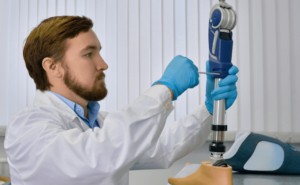If you're living with limb loss, finding the right prosthesis can feel overwhelming. Are prosthetic limbs a good fit? Choosing one isn't just about regaining mobility—it's about reclaiming independence, comfort, and confidence. In this guide, let’s explore types, costs, technology, and tips to help you decide what works best. Find out if a prosthesis is the right choice. Ready to find out? Let's begin!
Key Takeaways:
- Prosthetic Types:
- Below-Knee Prostheses: Lightweight, more straightforward, for lower-leg amputations.
- Above-Knee Prostheses: Include artificial knee joint; more complex.
- Body-powered vs. myoelectric: Body-powered uses cables, which are durable and low-maintenance. Myoelectric uses muscle signals for smoother, natural movement.
- Advanced Technology:
- Features like carbon fiber, microprocessors, and robotic joints improve stability and mobility.
- Mind-controlled and myoelectric systems allow precise, natural movements.
- Costs:
- Range: $5,000–$70,000. Customization, materials, and technology affect pricing.
- Insurance, charities (e.g., Limbs for Life), and programs assist with affordability.
- Customization & Adaptation:
- 3D printing ensures a precise fit. Misaligned devices cause pain. Regular prosthetist check-ups help.
- Specialized prostheses exist for sports, swimming, children, etc.
- Emotional and Physical Adaptation:
- Therapy improves mobility; support groups aid emotional coping.
- Financial Support:
- Nonprofits and free prosthetic programs (e.g., Limbs International) assist underserved communities.

What are the Different Types of Prostheses for Amputees?
When choosing a prosthesis, the first challenge is figuring out overall needs. There are two main categories: below-knee prostheses and above-knee prostheses. Below-knee prostheses, made for amputations below the knee joint, allow for easier movement. They're often lighter and simpler because they don't include a knee joint. In contrast, above-knee prostheses include an artificial knee joint, making them more complex but also essential for higher-level amputations. The choice depends on your amputation level and mobility goals. Learn more about prostheses and how they work.
Another significant distinction among advanced prosthetic technology is body-powered or myoelectric prostheses. Body-powered prostheses use cables and harness systems controlled by body movements, which makes them durable and easy to maintain. On the other hand, myoelectric prosthetics use electrical signals from your muscles. These advanced devices provide smoother and more natural movements but may need more careful handling and regular recharging.
Thanks to modern tools, prosthetic customization has significantly improved. Prostheses now feature lightweight materials like carbon fiber and innovations like microprocessors. These microprocessors adjust the prosthesis's position in real-time, letting you walk naturally and handle uneven terrain more easily. Robotic knees and ankles provide greater stability for daily tasks or physical activities.
Fitting a prosthesis to your unique body is critical. Today's technology, including 3D scanning and printing, creates precise, custom fits. It reduces discomfort and enhances function, making your prosthesis feel like a natural extension of your body. Resources like the Amputee Coalition offer valuable insights on selecting and adapting to prostheses, helping you find the right match for your lifestyle.
How Much Do Prosthetic Legs Cost for Amputees and What Factors Affect Pricing?
Prosthetic legs can run anywhere from $5,000 to $70,000. This wide range reflects differences in materials, technology, and customization. Basic mechanical prostheses are typically more affordable but provide fewer features. Advanced bionic legs, which include robotics and microprocessors, come with higher costs due to their specialized technology.
User needs also influence the price. Athletes may require prostheses designed for performance and flexibility, while daily users prioritize comfort and durability. Materials like carbon fiber and titanium make prostheses lighter and stronger, but these materials tend to be more expensive.
More cost-effective solutions are available for individuals on tighter budgets, including designs created to minimize expenses. Charities and programs also provide free or low-cost prostheses. Financial help, like the options outlined by Mass General, has brought hope to many families facing these challenges.
Insurance can offset some costs, though coverage depends on the provider and region. Some plans cover only basic models, with additional costs for upgrades. Government initiatives and nonprofit funding help further reduce expenses, especially for veterans and low-income individuals. Exploring all available options is essential to finding a solution within your budget.
Considerations When Choosing Among the Types of Prostheses for Amputees
Choosing the right prosthesis is a deeply personal decision, and it can often feel overwhelming. However, it is crucial to ensure a good fit and alignment, as these are vital for guaranteeing comfort and functionality. Therefore, using a qualified prosthetist becomes critical in achieving a secure, custom fit. Moreover, the prosthetic socket should ideally match the shape of your residual limb to avoid pain, balance issues, or skin irritation. Additionally, regular adjustments and check-ups can help address any issues as they arise.
Discomfort, such as skin irritation or pressure sores, is typical for first-time prosthetic users. These problems can often be fixed with softer liners, better socket adjustments, or changes in the suspension system that holds the prosthesis securely. Don't hesitate to talk to your prosthetist about any discomfort. There's no need to settle for pain.
Lifestyle needs play a significant role in prosthetic selection. Are you looking for something to support daily tasks or an option designed for running or hiking? High-tech bionic prostheses cater to active individuals by adapting to uneven ground, while simpler mechanical models serve well for users seeking durability and ease of use. Researching your options and asking detailed questions will guide you toward the best choice.
How Does Advanced Prosthetic Technology Improve Mobility?
Technological breakthroughs in different types of prostheses are changing the lives of amputees. Mind-controlled prosthetics, for instance, connect the nerves and muscles of a residual limb directly to the device, translating brain signals into motion. The Agonist-Antagonist Myoneural Interface (AMI) procedure equips these prosthetics with precise control, allowing for natural movements like climbing stairs or walking on uphill terrain.
Advanced prosthetic technology, such as robotic systems, is a promising innovation. With embedded microprocessors, sensors, and powered joints, these devices adjust in real-time to changing surfaces. Research from Massachusetts General Hospital highlights prosthetic ankles and knees that mimic human movement, reducing strain and boosting efficiency during long walks or athletic activities.
Prostheses designed for specific needs are also making mobility easier. Many newer models balance strength, weight, and function, whether intended for sports, daily routines, or other specialized activities. Materials like carbon fiber enhance both performance and comfort. Individuals using these advanced designs have demonstrated remarkable results, from participating in marathons to cycling. Explore more about these innovations here.
How Can Users Adapt to Life with Prostheses for Amputees?
Adjusting to life with a prosthesis requires a mix of physical and emotional readiness. Physical therapy is excellent for strengthening muscles, improving balance, and learning how to move confidently with a new prosthetic. Therapists offer practical exercises to make movements feel natural and reduce common issues, such as discomfort or difficulty with stairs.
Emotionally, many users experience frustration or sadness after limb loss. However, support groups and peer connections often ease this transition by offering understanding and shared experiences. Additionally, for those in need of emotional support, counseling services can help individuals and families process the change more effectively.
Community organizations also play a huge role. Groups such as the NHS Prosthetics Support Network offer helpful articles. These resources provide a valuable foundation for adapting to life with a prosthesis.
Financial Assistance Programs and Free Prosthetic Services
For many, the cost of the types of prostheses is a significant concern. Programs and charities exist to make prostheses more accessible. Here's what you need to know about financial assistance:
Which Organizations Offer Financial Assistance?
Government programs like Medicare or Medicaid often cover customized prostheses for eligible individuals. Nonprofits such as the Amputee Coalition also provide guidance and links to local services. Veterans can access free care and prostheses through the U.S. Department of Veterans Affairs. These organizations focus on minimizing financial burdens and enhancing access.
How Do Free Prostheses for Amputees Services Work?
Free prosthetic programs rely on donations and collaborations. Organizations like Limbs for Life and the Range of Motion Project (ROMP) help provide refurbished devices or new prostheses at no cost. Applicants usually need to meet criteria, such as proof of financial need. Partner hospitals and clinics often streamline the application process for these services.
Which Charities Focus on Prosthetic Donations?
Groups like Limbs International, for instance, focus on providing affordable and durable prostheses for underserved communities. Meanwhile, other organizations work locally to help individuals obtain advanced devices that are customized to their specific needs. Therefore, researching specific charities and understanding their eligibility criteria can ultimately help you find the right support. Visit the American Society for Surgery of the Hand for more resources.
Are There Specialized Prostheses for Different Lifestyles?
Specialized prostheses make it easier to enjoy specific activities. Runners often benefit from options made for speed and stability. These designs use a curved structure to store and release energy, letting you cover longer distances with less strain.
For swimmers, waterproof prostheses are indeed a reliable option. Firstly, they are made with corrosion-resistant materials; furthermore, these devices are buoyant and flexible, making them ideal for aquatic environments. Additionally, some even include movable joints to ensure smoother underwater movement.
Discover the Right Prostheses for Amputees with Our Expert Guidance
As the leading prostheses experts in Little Rock, we understand that choosing the right prosthesis can be a life-changing decision. Our team is dedicated to helping amputees find tailored solutions that enhance mobility and improve quality of life. We offer personalized consultations to assess your unique needs and recommend the best options available. Whether you're looking for advanced technology or something more traditional, our friendly and knowledgeable staff members are here to guide you every step of the way. Don't hesitate to contact us today—we're eager to assist you on your journey towards greater independence and comfort.



